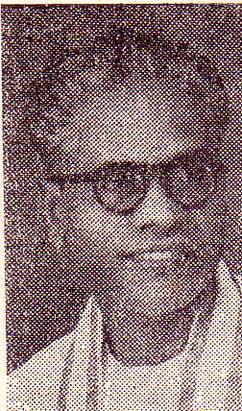K. P. Ratnam facts for kids
Quick facts for kids
K. P. Ratnam
|
|
|---|---|
|
கா. பொ. இரத்தினம்
|
|
 |
|
| Member of the Ceylonese Parliament for Kilinochchi |
|
| In office 1965–1970 |
|
| Preceded by | A. Sivasunderam |
| Succeeded by | V. Anandasangaree |
| Member of the Ceylonese Parliament for Kayts |
|
| In office 1970–1983 |
|
| Preceded by | V. Navaratnam |
| Personal details | |
| Born | 10 March 1914 Velanai, Ceylon |
| Died | 20 December 2010 (aged 96) Colombo, Sri Lanka |
| Political party | Illankai Tamil Arasu Kachchi |
| Other political affiliations |
Tamil United Liberation Front |
| Alma mater | University of London University of Madras |
| Profession | Academic |
Kaarthigesar Ponnambalam Ratnam (born March 10, 1914 – died December 20, 2010) was an important person from Sri Lanka. He was a smart academic, a politician, and a Member of Parliament. This means he helped make laws for his country.
Contents
Early Life and Education
K. P. Ratnam was born on March 10, 1914. His birthplace was Velanai, an island in northern Ceylon (now Sri Lanka). He went to Velanai Anglo-Vernacular School and Union College, Tellippalai.
He was very good at Tamil language and Tamil literature in school. He earned special titles for his knowledge of Tamil. Later, he earned a Bachelor of Arts degree from the University of London. He also received degrees from the University of Madras.
Ratnam married Sinthamany. They had one son named S. Nimalan.
A Career in Teaching and Research
Ratnam started his career as a teacher. From 1934 to 1940, he was the headmaster of Moolai Senior Secondary School. He then became an assistant teacher at Kopay Teacher Training College in 1941. In 1942, he was made an Inspector of Schools.
He taught Tamil at Maharagama Training College for many years. Later, he worked as a research officer in the Official Languages Department in Colombo. He also taught at Navalar Hall in Colombo. In 1964, he became a lecturer at the University of Malaya.
Entering Politics
After retiring from teaching, Ratnam decided to enter politics. He joined the Illankai Tamil Arasu Kachchi (also known as the Federal Party). In the 1965 election, he ran for Parliament in the Kilinochchi Electoral District. He won the election and became a Member of Parliament.
He ran again in the 1970 election for the Kayts Electoral District. He won this election too and continued to serve in Parliament.
Working for Tamil Rights
In 1972, several Tamil political parties joined together. They formed the Tamil United Front, which was later renamed the Tamil United Liberation Front (TULF). K. P. Ratnam was a part of this new group.
In 1976, Ratnam and other Tamil leaders were arrested. They were giving out leaflets and were accused of trying to cause trouble. They were taken to Colombo for a trial. Many famous Tamil lawyers helped defend them. In 1977, all the leaders, including Ratnam, were found not guilty.
Ratnam was re-elected to Parliament in 1977 as a TULF candidate for Kayts.
Leaving Parliament
In 1983, Ratnam and other TULF Members of Parliament stopped attending Parliament. This was for several reasons. There was pressure from Tamil groups not to stay in Parliament. Also, a new law required them to promise not to support a separate Tamil state. At the same time, violent events known as the Black July riots occurred. Many Tamils were harmed during these riots.
After three months of not attending, K. P. Ratnam lost his seat in Parliament in October 1983.
Later Life and Contributions
K. P. Ratnam was involved in many important organizations. He was the president of the Colombo Tamil Sangam. He also edited a magazine called Tamil World. He was a vice-president of the TULF.
He traveled to represent Tamil writers at conferences in New Delhi and Moscow. He wrote more than 12 books and many articles about literature and culture.
In 1985, Ratnam moved to India. He returned to Sri Lanka in 2003 and lived in Colombo. He passed away on December 20, 2010, at his home.
His Published Works
- Thavaram Illai (1948)
- Ilankayil Inpath Tamil (1956)
- Nootandugalil Tamil (1961)

